|
|
|
|
|
|
SEVEN LUCKY GODS MENU
Intro Page
Benzaiten
Bishamonten
Daikokuten
Ebisu 
Fukurokuju
Hotei
Jurōjin
Related EBISU Pages
Ebisu in Our Estore
Kamakura Seven Pilgrimage
Yomiuri Shimbun Story
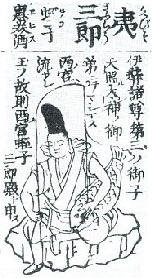
Ebisu as depicted in the
Butsuzō-zu-i 仏像図彙.
“Collected Illustrations of Buddhist Images.” Published in 1690.

Ebisu as depicted in the 1783
Zōho Shoshū Butsuzō-zui
増補諸宗仏像図彙
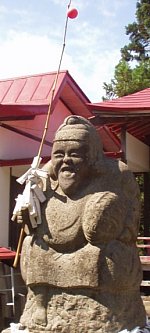
Ebisu at Iwaki Jinja (Aomori)
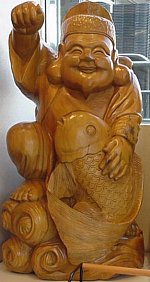
Modern Wood Statue
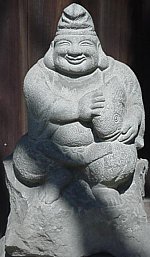
Ebisu at Zuisenji (Kamakura)
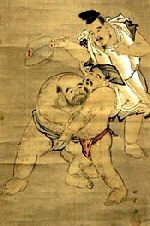
Scroll by Kitagawa Utamaro
喜多川歌麿 (1754-1806)
H = 82.3 cm, W = 39 cm
|
Says Gina Collia-Suzuki: The above scroll depicts three of the Seven Gods of Good Fortune engaged in a bout of Sumō wrestling. Daikoku (on the right), the god associated with wealth and prosperity, is shown wrestling with Hotei (on the left), the god of happiness and contentment. Behind them, Ebisu, the god of commerce, daily food, good luck and fishermen, is standing holding out a fan, acting as the referee for the match.
|
|

Stone, Circa 1920

Yahoo auction photo

Yahoo auction photo. |
|
|
|
|

EBISU (YEBISU) 恵比須
God of Good Fortune, the Ocean, & Fishing Folk
Deity of Honest Labor & Patron of Laborers
God of Fair Dealing, Maritime Tutelary
ORIGIN = JAPANOne of Japan’s Seven Lucky GodsAka Hiruko 蛭子. Also written 夷, 戎, 水蛭子、蛭児. Also known as Kotoshironushi 事代主神 Associated Virtue = Candor
|
SEVEN VIRTUES
Japan's Seven Lucky Gods are a popular grouping of deities
that appeared from the 15th century onward. The members of
the grouping changed over time, but a standardized set
appeared by the 17th century. In the 17th century, Japanese
monk Tenkai (who died in 1643 and was posthumously named
Jigen Daishi) symbolized each of the seven with an essential
virtue for the Shogun Tokugawa Iemitsu (1623-1650 AD).
The seven virtues are:
- Candour (Ebisu)
- Fortune (Daikokuten)
- Amiability (Benzaiten)
- Magnanimity (Hotei)
- Popularity (Fukurokuju)
- Longevity (Juroujin)
- Dignity (Bishamonten)
References: Flammarion Iconographic Guide - Buddhism
|
ANIMAL ASSOCIATIONS
Red Snapper, Sea Bream, Jellyfish
Male. Popular among fishing folk, sailors, famers, and people in the food industry, the smiling and often bearded Ebisu 恵比須 (also written 恵美酒 or 恵比寿) is commonly shown wearing formal court garments or the hunting robes of a courtier, but his main attributes are the fishing rod in his right hand and a large red sea bream or a red snapper (Jp. = tai 鯛) dangling from the line or tucked under his left arm. In Japan, these two fish symbolize fortune (the Japanese term for joyous occasions is omede-tai). Ebisu is also depicted wearing a pointed hat (Kazaori Eboshi 風折烏帽子) folded in the middle, which was worn by courtiers of the imperial court in olden times. Less commonly, Ebisu is depicted carrying a folding fan rather than a fish or fishing rod. The meaning of the fan is unclear, but it no doubt symbolizes the granting of wishes or making of judgments -- in olden times, the fan was waved by the emperor in a certain direction to indicate either acceptance or rejection of a request during the emperor’s audiences with nobles and commoners.
In a nation fond of fish, Ebisu is not surprisingly one of the most popular of the Seven Lucky Gods. Ebisu is also the only deity among the seven to originate in Japan. Today he symbolizes not only safe sailing and plentiful fishing, but business prosperity for merchants in all trades and success to people in any occupation. In artwork, Ebisu is often paired with Daikoku (Hindu origin; god of agriculture and rice). Indeed, in some traditions, Ebisu is considered the son of Daikoku. Statues of the pair can be found everywhere in modern Japan -- the two together are perhaps the most popular motif of good luck nationwide. The Ebisu-Daikoku duet are also enshrined in kitchens, especially in farming communities.
Ebisu is worshipped at numerous sanctuaries. At Nishinomiya Jinja 西宮神社 (Hyogō Prefecture), the head shrine of Ebisu worship in Japan, it is said that Ebisu is rather deaf. Thus arose, says the shrine, the widespread custom of clapping hands before one prays to shrine deities in order to gain the attention of the gods. In January and October each year, many localities still celebrate the Ebisu-kō 夷子講 (Ebisu Festival), during which local merchants, shops, and department stores give special discounts. The Ebisu-kō tradition originated sometime in the early Edo period as a way to alleviate the guilty conscience of merchants who bought cheap and sold high. Since Ebisu is the God of Fair Dealing, merchants apparently began offering bargain sales as a penance and apology to Ebisu.
Says the Encyclopedia of Shinto (Kokugakuin Univ.)
There is documentation that in the first year of the Chōkan Era (1163), Ebisu was being invoked (kanjō) at Tōdaiji in Nara as a guardian deity of markets; the same is noted for the fifth year of the Kenchō Era (1253) at Tsurugaoka Hachimangū in Kamakura.
HIRUKO, THE LEACH CHILD (aka Ebisu)
In some traditions, Ebisu is considered the son of Shintō deity Ōkuninushi 大国主命 (aka Daikokuten; god of agriculture), and in this capacity is known as Kotoshironushi 事代主神. In others traditions, he is said to have been a real man, a member of the ruling class, one loved by the people but one who was passionate about fishing -- and thus needed to be found before court meetings. <Source: Chiba Reiko, pp. 17-20 > There are other conflicting stories. The Kojiki (720 AD) and Nihongi (circa 797 AD), two of Japan's oldest chronicles, describe a deity named Hiruko 蛭子 (literally “Leach Child”). Hiruko was the son of the Shinto gods Izanagi 伊邪那岐命 and Izanami 伊邪那美命, the progenitors of the islands of Japan. Since he was born without any bones, Hiruko was set adrift in the ocean at age three. Somehow he returned to land and was cared for by one Ebisu Saburo. He overcame many hardships and later became the god Ebisu. He's also considered the god of the morning sun, and he guards the health of little children, as does Hotei (another member of Japan’s Seven Lucky Gods). Indeed, there are many patrons of children in Japanese traditions. Because he was born without bones, he is sometimes associated with jellyfish. > There are other conflicting stories. The Kojiki (720 AD) and Nihongi (circa 797 AD), two of Japan's oldest chronicles, describe a deity named Hiruko 蛭子 (literally “Leach Child”). Hiruko was the son of the Shinto gods Izanagi 伊邪那岐命 and Izanami 伊邪那美命, the progenitors of the islands of Japan. Since he was born without any bones, Hiruko was set adrift in the ocean at age three. Somehow he returned to land and was cared for by one Ebisu Saburo. He overcame many hardships and later became the god Ebisu. He's also considered the god of the morning sun, and he guards the health of little children, as does Hotei (another member of Japan’s Seven Lucky Gods). Indeed, there are many patrons of children in Japanese traditions. Because he was born without bones, he is sometimes associated with jellyfish.
HIRUKO MYTHOLOGY (aka Ebisu)
Says Nishioka Kazuhiko at the Encyclopedia of Shinto (Kokugakuin University): “Hiruko was a deformed infant born to Izanagi and Izanami as a result of Izanami's mistake in speaking first to Izanagi during their courtship. The child was placed in a reed boat and set adrift. The meaning of the child's name is debated, although hiruko means "leach," and the name may suggest a child with arms and legs but without bones. The main text of Nihongi states that the child could not walk even after reaching three years of age, with the result that he was placed in the ’rock-camphor boat of heaven’ and set adrift to the mercy of the winds. In later times, Hiruko was identified with Ebisu, a maritime tutelary and one of the Seven Gods of Good Fortune.” <end quote>
KOTOSHIRONUSHI (aka Ebisu)
Says Kadoya Atsushi at the Encyclopedia of Shinto (Kokugakuin University): “Kotoshironushi is the offspring of kami Ōkuninushi 大国主命 (aka Daikokuten; god of agriculture). As part of the pacification of the ’Central Land of Reed Plains,’ Takemikazuchi, envoy of the heavenly kami, confronted the earthly kami Ōkuninushi and asked him to relinquish the land. Ōkuninushi entrusted his son Kotoshironushi with his response, whereupon Kotoshironushi pledged allegiance to the heavenly kami, and ’hid himself away’ inside an enclosure of green leaves which he had made in the ocean. Based on this event, Kotoshironushi is viewed as an oracular deity transmitting the will of other kami. He also appears as an oracular deity in Nihongi's account of Empress Jingū and Emperor Tenmu. With the maid Mizokuhihime of Mishima (in Settsu Province), Kotoshironushi had a child named Himetataraisuzuhime, who later became the wife of Emperor Jinmu. Kotoshironushi is an object of worship (saijin 祭神) at shrines such as Miho Jinja in Shimane and Mishima Jinja in Shizuoka.” <end quote>
EBISU IN JAPANESE MYTHOLOGY
Below Text Courtesy of JAANUS
Ebisu 恵比須 is one of the Seven Gods of Good Fortune (Shichifukujin 七福神). Ebisu is regarded as the tutelary deity of all occupations, but especially of fishing, farming and commerce. The main attributes of Ebisu are his fishing rod, held in his right hand or over his right shoulder, and a freshly caught, large red snapper or sea bream (tai 鯛, a symbol of good fortune) under his left arm. He is a plump figure with a broadly grinning face, usually shown sitting on a rock. He may wear a kimono 着物 and divided skirt hakama 袴, or sashinuki 指貫, a type of Heian period hakama gathered in at the ankles, or sometimes kariginu 狩衣, the ancient hunting robes which became the ordinary apparel of Heian period courtiers. On his head, he wears a tall, pointed cap folded in the middle called kazaori eboshi 風折烏帽子. His happy expression and attributes of prosperity make him a popular god among merchants. Ebisu is frequently paired with the god Daikokuten 大国天, who is also one of the Seven Gods of Good Fortune. The two gods are often enshrined in the kitchen, especially in farming communities.
Worship of Ebisu became very popular during the Edo period, when Ebisu dolls were mass-produced and sold throughout the countryside by traveling Ebisu puppeteers (ebisumawashi 恵比須回 or ebisukaki 夷舁) mainly from Nishinomiya 西宮 in Hyougo Prefecture. Dolls or portraits were used by believers at festival rites, ebisukou 夷子講, held on October 20th (or in January in some regions) to celebrate Ebisu and pray for prosperity. Ebisu was a popular subject painted by various artists of the Edo period including Kanou Tan'yuu 狩野探幽 (1602-74) and Ogata Kourin 尾形光琳 (1659-1716). In Ootsu-e drawings 大津絵, Ebisu and Daikokuten are sometimes caricatured as two figures engaged in a bout of sumo 相撲 wrestling. The name Ebisu is derived from the term for "foreigner" or "barbarian" and thought to reflect the early worship of deities bringing desired skills from distant lands.
Ebisu, the god of commerce, is represented in Kyougen 狂言 plays by a masked figure (Kyougenmen 狂言面). The Ebisu mask has a generous, laughing expression; his eyes are narrowed, forehead gently furrowed, and mouth wide open in a broad smile. His moustache and eyebrows are painted in fine black lines. Ebisu appears in celebratory kyougen plays such as “Ebisu and Daikoku” (EBISU DAIKOKU 恵比須大黒) and “Ebisu and Bishamon” (EBISU BISHAMON 恵比須毘沙門). The Ebisu mask was also frequently used to represent the god of happiness, Fuku-no-kami 福の神, the main character in the play FUKUNOKAMI. <end quote from JAANUS>
Says Flammarion Iconographic Guide (page 239):
- Ebisu is worshipped in the region of Osaka, where his feast is celebrated each year on 9 and 10 January and 20 October by tradesmen who strike the walls of his sanctuary with mallets to call him, because he is believed to be rather deaf. Large radishes (daikon) steeped in vinegar (bettara) are offered to him as tributes. Sanctuaries are dedicated to him throughout Japan -- that of Nishi no Miya (Hyogo Prefecture) is famous and attracts many pilgrims.
- Japanese fishermen invoke Ebisu before going to sea or diving. They symbolize him by a large stone which a young boy must fish from the bottom of the water at certain times of the year.
- In some parts of Japan, especially Kyushu, the deity of farms is also named Ebisu, and some groups of hunters on this island call the monkeys by the same name. <end quotes from Flammarion Guide>
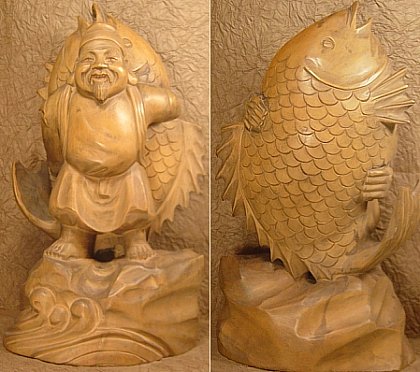
Statues of Ebisu are Available for Online Purchase
at www.buddhist-artwork.com, our sister site
  
Daikoku, Ebisu, and Hotei. Click images to enlarge.
Above photos thanks to Robert Yellin, the owner of above pieces.
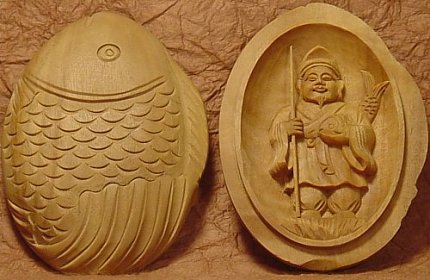
Ebisu Amulet (Sandalwood) | Modern
Available for online purchase at our Sister Site


|

Ebisu icon for Japanese beer
named Yebisu (Sapporo Brewery)

Ebisu, 19th century, Ebisu, Wood Carving
Photo courtesy of rarebooksinjapan.com
|
|
 SOURCES SOURCES
- Butsuzō zui 仏像図彙 (Illustrated Compendium of Buddhist Images). Published in 1690 (Genroku 元禄 3). A major Japanese dictionary of Buddhist iconography. Hundreds of black-and-white drawings, with deities classified into categories based on function and attributes. For an extant copy from 1690, visit the Tokyo Metropolitan Central Library. An expanded version, known as the Zōho Shoshū Butsuzō-zui 増補諸宗仏像図彙 (Enlarged Edition Encompassing Various Sects of the Illustrated Compendium of Buddhist Images), was published in 1783. View a digitized version (1796 reprint of the 1783 edition) at the Ehime University Library. Modern-day reprints of the expanded 1886 Meiji-era version, with commentary by Ito Takemi (b. 1927), are also available at this online store (J-site). In addition, see Buddhist Iconography in the Butsuzō-zui of Hidenobu (1783 enlarged version), translated into English by Anita Khanna, Jawaharlal Nehru University, New Delhi, 2010.
- JAANUS -Seven Lucky Gods Page. Japanese Architecture and Art Net Users System. A wonderful online dictionary compiled by the late Dr. Mary Neighbour Parent. It covers both Buddhist and Shinto deities in great detail. Over 8,000 entries. Written in English, yet presenting all key terms in Japanese.
- JAANUS - Ebisu Page. Says JAANUS: The name Ebisu is derived from the term for "foreigner" or "barbarian" and thought to reflect the early worship of deities bringing desired skills from distant lands.
- Buddhism (Flammarion Iconographic Guides)
 , by Louis Frederic, Printed in France, ISBN 2-08013-558-9, First published 1995. A highly illustrated volume, with special significance to those studying Japanese Buddhist iconography. Includes many of the myths and legends of mainland Asia as well, but its special strength is in its coverage of the Japanese tradition. Hundreds of accompanying images/photos, both B&W and color. , by Louis Frederic, Printed in France, ISBN 2-08013-558-9, First published 1995. A highly illustrated volume, with special significance to those studying Japanese Buddhist iconography. Includes many of the myths and legends of mainland Asia as well, but its special strength is in its coverage of the Japanese tradition. Hundreds of accompanying images/photos, both B&W and color.
- Essentials of Buddhist Images: A Comprehensive Guide to Sculpture, Painting, and Symbolism. By Kodo Matsunami. Paperback; first English edition March 2005; published by Omega-Com. Matsunami (born 1933) is a Jōdo-sect 浄土 monk, a professor at Ueno Gakuen University, and chairperson of the Japan Buddhist Federation. He received the government's Medal of Honor (褒章 hōshō), Blue Ribbon, for his achievements in public service. Says Matsunami: “Bishamonten protects from disaster and bodily harm. Daikoku satisfies the deisre for food. Benzaiten represents sexual desire. Hotei brings laughter, and Ebisu grants wealth.
- Tobifudo Deity Dictionary. Ryūkozan Shōbō-in Temple 龍光山正寶院 (Tokyo). Tendai Sect.
- The Seven Lucky Gods of Japan
 , by Chiba Reiko. Charles E. Tuttle Co., 1966. , by Chiba Reiko. Charles E. Tuttle Co., 1966.
- Encyclopedia of Shinto - Ebisu. From Kokugakuin University, Japan.
- UCLA Center for East Asian Studies, Educational Resources from teacher Samantha Wohl, Palms Middle School, Summer 2000. See Wohl’s Materials List (based on Chiba Reiko’s book).
LEARN MORE

This is a side page.
Return to Seven Lucky Gods Main Page.
|
|